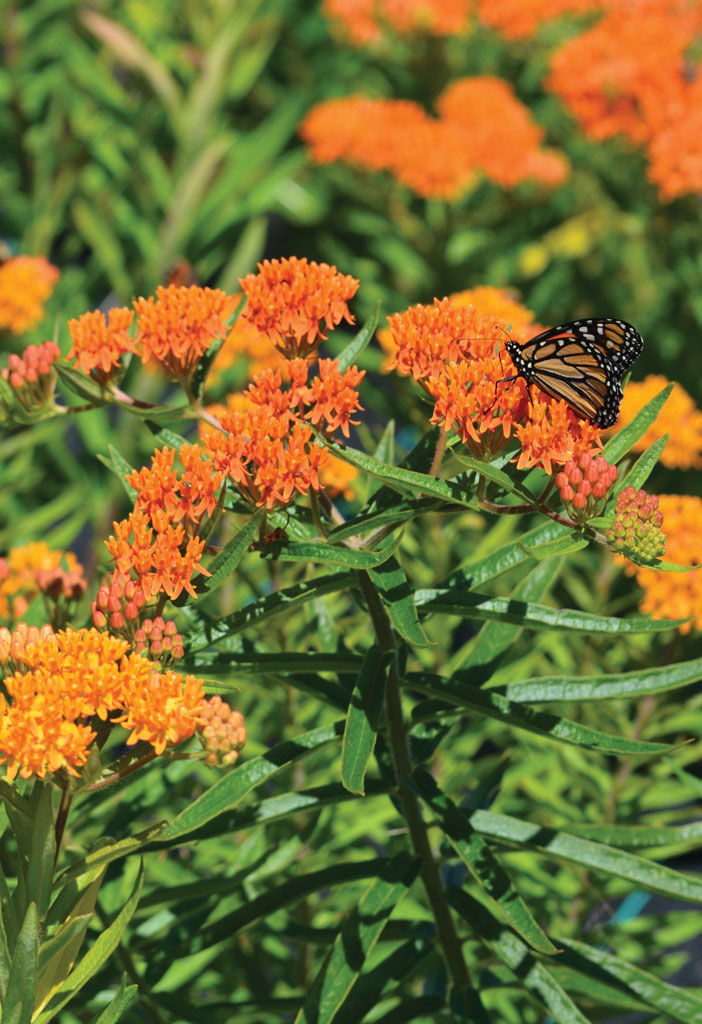Butterfly Weed, or Asclepias tuberosa, is a vibrant, perennial native prized for its blazing clusters of orange blossoms and remarkable appeal to pollinators. Often called “Orange Milkweed,” this sun-loving beauty thrives in poor, well-drained soils and brings a burst of color to butterfly gardens, prairie restorations, and mixed borders from late spring through summer. Beyond its ornamental value, Butterfly Weed is indispensable for monarch butterflies—their larvae feed exclusively on milkweeds—making it a cornerstone species for wildlife-friendly landscapes in Southeast Wisconsin.
Key Characteristics
-
Flower & Bloom Time
-
Showy umbels of 10–50 bright orange to reddish-orange flowers
-
Blooms from late May through July, with potential for rebloom under ideal conditions
-
Fragrant nectar guides attract a host of butterflies, bees, and hummingbirds
-
-
Foliage & Form
-
Erect, clump-forming habit reaching 1–2 ft tall and wide
-
Smooth, lanceolate leaves (3–6 in long) arranged alternately along sturdy stems
-
Leaves may take on a bluish-green hue in full sun, adding textural contrast
-
-
Root System
-
Tuberous roots that tolerate drought and poor soils once established
-
Avoid disturbance—deep roots make transplants challenging
-
Cultural Requirements
-
Light
-
Thrives in full sun (at least 6 hours daily)
-
May tolerate light afternoon shade but blooms best under direct sun
-
-
Soil
-
Prefers well-drained, sandy or rocky soils
-
Tolerates poor, dry soils; struggles in heavy clay or poorly drained sites
-
Incorporate grit or coarse sand at planting for optimal drainage
-
-
Water
-
Drought-tolerant once roots develop (2–3 months)
-
Water regularly during establishment; thereafter, supplemental water only in extreme drought
-
-
Hardiness
-
USDA Zones 3–9
-
Cold-hardy; foliage dies back in fall, roots overwinter beneath mulch
-
Landscape Uses & Companion Plants
-
Pollinator & Butterfly Gardens
-
Attracts monarchs, fritillaries, swallowtails, and native bees
-
Plant in groups of five or more for maximum visual impact and nectar availability
-
-
Prairie & Meadow Restorations
-
Blends seamlessly with native grasses (e.g., Little Bluestem, Schizachyrium scoparium)
-
Complements other prairie forbs such as Purple Coneflower (Echinacea purpurea), Black-eyed Susan (Rudbeckia hirta), and Wild Bergamot (Monarda fistulosa)
-
-
Mixed Perennial Borders
-
Pair with cool-season bloomers (e.g., Columbine Aquilegia canadensis) for sequential interest
-
Contrast with fine-textured sedges (e.g., Pennsylvania Sedge Carex pensylvanica)
-
-
Dry Sunny Beds & Rock Gardens
-
Ideal for xeriscapes and rockeries where moisture is limited
-
Highlights textural gravel or stone with its bold floral umbels
-
Seasonal Care & Maintenance
-
Planting & Division
-
Best planted in spring after last frost; space 12–18″ apart
-
Avoid frequent division—disturbing tuberous roots can reduce vigor
-
To propagate, collect seed pods in late summer and sow fresh in fall or stratify for spring planting
-
-
Deadheading & Staking
-
Remove spent flower clusters to tidy appearance; leaving a few allows seeds to self-sow if desired
-
Mature plants with heavy blooms may benefit from light staking to prevent flopping
-
-
Fertilization
-
Low fertilizer needs; a light application of compost or balanced slow-release fertilizer in spring is sufficient
-
Overfertilizing can lead to fewer flowers and weaker stems
-
-
Pest & Disease Management
-
Relatively pest-free; occasional aphids can be managed with a strong spray of water or insecticidal soap
-
Resistant to deer and rabbits due to milky sap
-
Good air circulation prevents fungal issues—avoid overhead watering
-
-
Winter Care
-
After foliage dies back, cut stems to ground level or mulch lightly to protect roots in colder microclimates
-
Remove heavy mulch in early spring to allow new shoots to emerge unimpeded
-
Ecological Benefits
-
Monarch Conservation: As a true milkweed, Butterfly Weed is crucial for monarch larvae, helping strengthen declining butterfly populations.
-
Pollinator Magnet: Beyond monarchs, its flowers feed swallowtails, skippers, hummingbirds, and a variety of native bees.
-
Erosion Control: Deep, fibrous roots stabilize sandy or gravelly soils on slopes and embankments.
Conclusion & Availability
Butterfly Weed (Asclepias tuberosa) shines with its fiery blooms, ecological value, and ease of care—making it an essential addition to any Southeast Wisconsin garden. Whether you’re restoring a prairie pocket, enhancing a pollinator haven, or seeking low-maintenance summer color, this native superstar delivers year after year.
Ready to welcome monarchs and other pollinators to your landscape? Visit Heritage Hill Nursery in New Berlin or explore our online store to secure healthy Butterfly Weed plants and give your garden a bright, sustainable boost this season!

